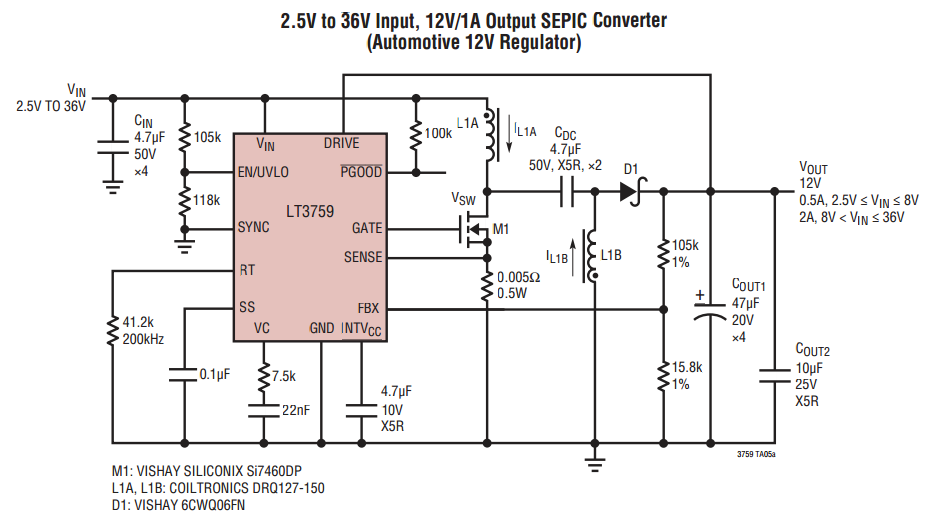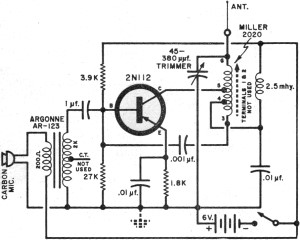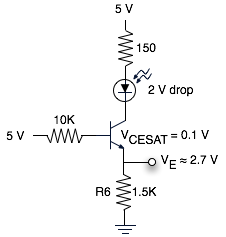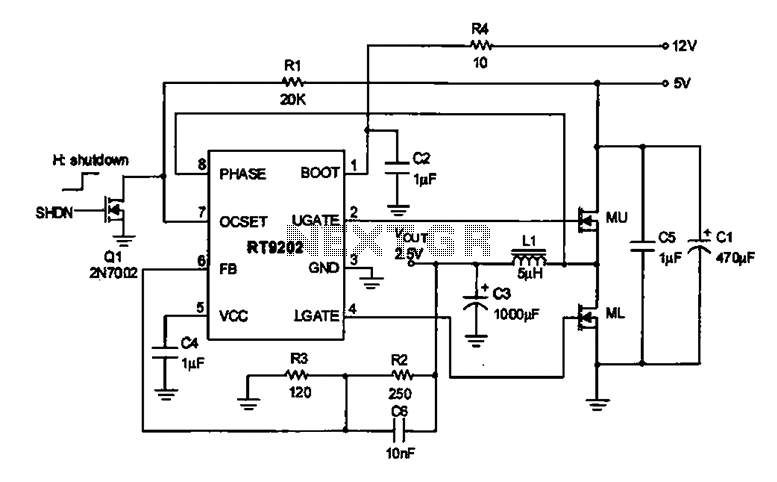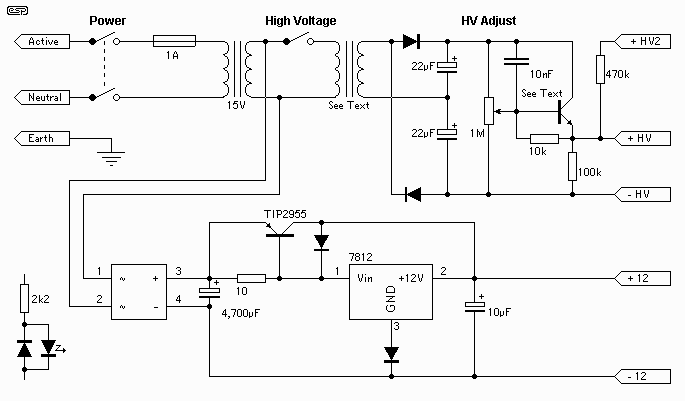
Controlled Transistor Series Regulator With Overload and Short-Circuit Protection
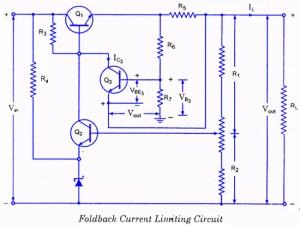
If the load resistance (RL) is reduced or the load terminals are accidentally shorted, a very large load current will flow, potentially damaging the pass transistor (Q1), diode, or other components. Fuse protection may not be sufficient, as the transistor can be damaged in a fraction of a second. The current limiting circuit consists of a transistor (Q3) and a resistor (R5, approximately 1 ohm) connected between the base and emitter terminals of transistor Q3. Under normal load current conditions, transistor Q3 remains off because the voltage drop across resistor R5 is small (less than about 0.7 V, which is necessary to turn on transistor Q3). In this state, the circuit operates normally. However, when the load current exceeds 600 mA, the voltage drop across R5 becomes significant enough to turn on transistor Q3. The collector current of transistor Q3 flows through resistor R3, reducing the base voltage of transistor Q1, which decreases its conduction level, thus preventing further increases in load current. When load resistance RL is infinite, the output voltage is regulated at VREQ, with a load current IL of zero. As RL decreases, IL increases until it reaches a minimum load resistance (RL(min)) where IL equals 600 mA and VBE equals 0.6 V. Beyond this point, transistor Q3 activates, and current limiting occurs. If RL is zero, IL is limited to a value between 600 mA and 700 mA. The load current with shorted load terminals is indicated as ISL. When the load terminals are shorted, the voltage across resistor R5 is significant. The simple current limiting circuit has a drawback of high power dissipation across the series pass transistor. With a short circuit, nearly all the input voltage appears across the pass transistor, causing it to dissipate significant power. The foldback current limiting circuit addresses this issue. In this circuit, the base of transistor Q3 is biased by a voltage divider network comprised of resistors R6 and R7. The load current IL flows through resistor R5, resulting in a voltage drop across it. This voltage, combined with the output voltage, affects the voltage divider network. The voltage at the base of transistor Q3 is determined by the drop across resistor R7. As load resistance decreases, IL increases, causing an increase in the voltage drop across R5, which in turn increases the base drive of transistor Q3. This enhanced drive causes Q3 to turn on more strongly, increasing its collector current, which flows through resistor R3 and reduces the base voltage of transistor Q1, limiting its conduction. This process effectively limits the increase in load current. Due to the design of this circuit, the VBE in this configuration is greater than in the previous circuit, allowing for more significant load current limiting. As RL decreases, VBE3 increases until Q3 saturates, at which point its collector current remains constant, and further decreases in RL do not affect the system.
The described circuit functions as a robust current limiting mechanism to protect the components from excessive load currents. The inclusion of the foldback current limiting circuit enhances the reliability of the voltage regulator by reducing the power dissipation across the pass transistor during fault conditions. The voltage divider network, which biases transistor Q3, plays a critical role in ensuring that the base voltage is adequately controlled, enabling timely activation of the current limiting feature. This design is essential in applications where load conditions may fluctuate, ensuring that the circuit can handle unexpected changes without compromising component integrity. The careful selection of resistor values and the characteristics of the transistors involved are crucial for achieving the desired performance and protection levels in the system.If the load resistance RL is reduced or load terminals are shorted acciden tally, a very large load current will flow. It may destroy the pass transistor Q1, diode or possibly some other component. Fuse protection will not prove adequate because the transistor may get damaged in a very small fraction of a second The current limit ing circuit con
sists of a transistor Q3 and a re sistor R5 (approxi mately 1 ohm) connected between base and emitter terminals of transistor Q3. With normal load current, transistor Q3 remains off because the voltage drop across resistor R5 is small (less than about 0.
7 V necessary for making the transistor Q3 on). Under this condition, the circuit works normally, as described above. With the excessive load current (exceeding 0. 6/1, that is, 0. 6 A or 600 mA) the voltage drop across R5 becomes large enough to turn transistor Q3 on. The collector current of transistor Q3 flows through R3 thereby decreasing the base voltage of transistor Q1. This results in reduction of the conduction level of transistor Q1. Thus further increase in load current is prevented. Figure summarizes the current limiting. When load resistance RL is infinite, the output voltage is regulated and has a value of VREQ. The load current IL is zero for this operating condition. When RL decreases, the load current IL increases upto the point where RL becomes equal to RL(min) At this minimum load resist ance, IL equals 600mA and VBE equals 0.
6V. Beyond this point, transistor Q3 turns on and the current limiting sets in. Further decrease in RL produces decrease input voltage, and regulation is lost. When RL is zero, the load current IL is limited to a value between 600 m A and 700 m A. The load current with shorted-load terminals is symbolized as ISL. When the load terminals are shorted in fig. 30. 9, the volt age across resistor R5 is The simple current limiting circuit also has a drawback of large power dissipation across the series pass transistor. With a short across the load, almost all the input voltage appears across the pass transistor. So the pass transistor has to dissipate approximately A problem with the simple current limiting circuit just discussed is that there is a large amount of power dissipation in series pass transistor Q1 while the regulator remains short-circuited.
The foldback current limiting circuit is the solution of above problem. The circuit of a transistor series voltage regulator with foldback current limiting facility is illustrated in the figure. In this circuit base of transistor Q3 is biased by a voltage divider network consisting of resistors R6 and R7.
The load current IL flows through resistor R5, causing a voltage drop of IlR5(approximately) across it. Thus a voltage of (IlR5 + Vout) acts across the voltage divider (R6 R7) network. The voltage applied to the base of transistor Q3 is equal to the voltage drop across resistor R7 and is given as Thus the magnitude of base drive of transistor Q1 is by this Vbe3.
Now if load resistance decreases, may be due to any reason, load current IL will increase causing voltage drop Il, R5 to increase. This causes VB3 to increase and therefore Vbe3 to increase. This makes transistor Q3 on in a stronger way. The increased collector current Ic3 of transistor Q3 flows through the resistor R3 thereby decreasing the base voltage of transistor Q1 This results in reduction of the conduction level of transistor Q1.
Thus further increase in load current is prevented. From the equations above it is obvious that VBE in this circuit is much more than that was in circuit illustrated in the above figure(only ILR5). It means that the increment in load current is limited by larger amount in circuit shown in figure. Due to reduction in load resistance RL, VBE3 increases to a level so that transistor Q3 gets saturated.
Now collector current Ic3 becomes constant. Any further decrease in RL will have no effect on 🔗 External reference
The described circuit functions as a robust current limiting mechanism to protect the components from excessive load currents. The inclusion of the foldback current limiting circuit enhances the reliability of the voltage regulator by reducing the power dissipation across the pass transistor during fault conditions. The voltage divider network, which biases transistor Q3, plays a critical role in ensuring that the base voltage is adequately controlled, enabling timely activation of the current limiting feature. This design is essential in applications where load conditions may fluctuate, ensuring that the circuit can handle unexpected changes without compromising component integrity. The careful selection of resistor values and the characteristics of the transistors involved are crucial for achieving the desired performance and protection levels in the system.If the load resistance RL is reduced or load terminals are shorted acciden tally, a very large load current will flow. It may destroy the pass transistor Q1, diode or possibly some other component. Fuse protection will not prove adequate because the transistor may get damaged in a very small fraction of a second The current limit ing circuit con
sists of a transistor Q3 and a re sistor R5 (approxi mately 1 ohm) connected between base and emitter terminals of transistor Q3. With normal load current, transistor Q3 remains off because the voltage drop across resistor R5 is small (less than about 0.
7 V necessary for making the transistor Q3 on). Under this condition, the circuit works normally, as described above. With the excessive load current (exceeding 0. 6/1, that is, 0. 6 A or 600 mA) the voltage drop across R5 becomes large enough to turn transistor Q3 on. The collector current of transistor Q3 flows through R3 thereby decreasing the base voltage of transistor Q1. This results in reduction of the conduction level of transistor Q1. Thus further increase in load current is prevented. Figure summarizes the current limiting. When load resistance RL is infinite, the output voltage is regulated and has a value of VREQ. The load current IL is zero for this operating condition. When RL decreases, the load current IL increases upto the point where RL becomes equal to RL(min) At this minimum load resist ance, IL equals 600mA and VBE equals 0.
6V. Beyond this point, transistor Q3 turns on and the current limiting sets in. Further decrease in RL produces decrease input voltage, and regulation is lost. When RL is zero, the load current IL is limited to a value between 600 m A and 700 m A. The load current with shorted-load terminals is symbolized as ISL. When the load terminals are shorted in fig. 30. 9, the volt age across resistor R5 is The simple current limiting circuit also has a drawback of large power dissipation across the series pass transistor. With a short across the load, almost all the input voltage appears across the pass transistor. So the pass transistor has to dissipate approximately A problem with the simple current limiting circuit just discussed is that there is a large amount of power dissipation in series pass transistor Q1 while the regulator remains short-circuited.
The foldback current limiting circuit is the solution of above problem. The circuit of a transistor series voltage regulator with foldback current limiting facility is illustrated in the figure. In this circuit base of transistor Q3 is biased by a voltage divider network consisting of resistors R6 and R7.
The load current IL flows through resistor R5, causing a voltage drop of IlR5(approximately) across it. Thus a voltage of (IlR5 + Vout) acts across the voltage divider (R6 R7) network. The voltage applied to the base of transistor Q3 is equal to the voltage drop across resistor R7 and is given as Thus the magnitude of base drive of transistor Q1 is by this Vbe3.
Now if load resistance decreases, may be due to any reason, load current IL will increase causing voltage drop Il, R5 to increase. This causes VB3 to increase and therefore Vbe3 to increase. This makes transistor Q3 on in a stronger way. The increased collector current Ic3 of transistor Q3 flows through the resistor R3 thereby decreasing the base voltage of transistor Q1 This results in reduction of the conduction level of transistor Q1.
Thus further increase in load current is prevented. From the equations above it is obvious that VBE in this circuit is much more than that was in circuit illustrated in the above figure(only ILR5). It means that the increment in load current is limited by larger amount in circuit shown in figure. Due to reduction in load resistance RL, VBE3 increases to a level so that transistor Q3 gets saturated.
Now collector current Ic3 becomes constant. Any further decrease in RL will have no effect on 🔗 External reference
Warning: include(partials/cookie-banner.php): Failed to open stream: Permission denied in /var/www/html/nextgr/view-circuit.php on line 713
Warning: include(): Failed opening 'partials/cookie-banner.php' for inclusion (include_path='.:/usr/share/php') in /var/www/html/nextgr/view-circuit.php on line 713
